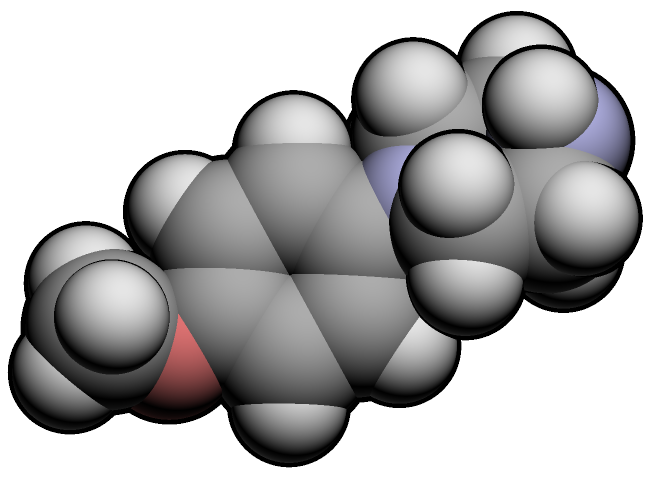Summary
Para-Methoxyphenylpiperazine (MeOPP, pMPP, 4-MPP; commonly known as Paraperazine) is a piperazine-derived compound known for its stimulant properties. It gained notoriety for being incorporated into “Party pills,” initially introduced in New Zealand and later distributed in various countries across the globe.
| Identifiers | |
|---|---|
| IUPAC name | |
| CAS Number | 38212-30-5 |
|---|---|
| PubChem CID | 269722 |
| ChemSpider | 237180 |
| UNII | P385M92GYG |
| CompTox Dashboard (EPA) | DTXSID30191591 |
| ECHA InfoCard | 100.048.918 |
| Chemical and physical data | |
| Formula | C11H16N2O |
| Molar mass | 192.262 g·mol−1 |

Pharmacology
MeOPP is often reported anecdotally to induce notably lower levels of anxiety when compared to similar piperazine compounds. It is typically consumed in the range of 120–200 mg. Unlike other piperazines with pronounced stimulant effects, MeOPP is reputed to have a relaxing influence. However, it is frequently combined with stimulant piperazine derivatives like benzylpiperazine (BZP) to achieve a combined effect.
In vitro studies have revealed that MeOPP can inhibit the reuptake and promote the release of monoamine neurotransmitters. This mechanism of action is shared with substances of abuse like amphetamines, resulting in somewhat similar effects. However, MeOPP is considerably less potent and is believed to possess relatively limited abuse potential. Additionally, like other piperazine derivatives, such as trifluoromethylphenylpiperazine (TFMPP), MeOPP has been shown to engage with serotonin receptors in a nonselective manner.
Legal status
In New Zealand, following the recommendation of the EACD, the government enacted legislation that classified BZP and several other piperazine derivatives under Class C of the New Zealand Misuse of Drugs Act 1975. Initially slated to take effect on December 18, 2007, the legal change was delayed until the subsequent year. Consequently, the sale of BZP and the other specified piperazines was prohibited in New Zealand starting from April 1, 2008. An amnesty period allowing possession and use of these substances continued until October 2008, after which they became entirely illegal.
In the United States, MeOPP is not subject to federal scheduling at the national level.
However, in the state of Florida, “Methoxyphenylpiperazine” is classified as a Schedule I controlled substance. This designation renders it illegal to purchase, sell, or possess this substance in the state of Florida.
FAQ
- What is para-methoxyphenylpiperazine (MeOPP)?
- Para-methoxyphenylpiperazine, often referred to as MeOPP, is a piperazine derivative known for its stimulating effects. It has been used as an ingredient in products like “Party pills” and gained popularity in New Zealand before spreading to other parts of the world.
- What are the typical effects of MeOPP?
- MeOPP is often associated with mild stimulating effects, but it is also said to induce relaxation, as reported anecdotally. It’s known to cause less anxiety compared to some other piperazine derivatives. Some users combine it with stimulant piperazines like benzylpiperazine (BZP) for a combined effect.
- What is the usual dosage for MeOPP?
- Users typically take MeOPP at doses ranging from 120 to 200 milligrams. However, it’s important to note that individual responses to the substance may vary, and careful dosage is advisable.
- How does MeOPP work in the body?
- In vitro studies have shown that MeOPP inhibits the reuptake and induces the release of monoamine neurotransmitters. This mechanism of action shares similarities with substances like amphetamines, leading to somewhat similar effects. While it is less potent and believed to have relatively low abuse potential, it still affects the neurotransmitter system.
- Do any government authorities regulate MeOPP?
- Regulation of MeOPP varies by country. For example, in New Zealand, it was classified as a Class C substance under the Misuse of Drugs Act, making its sale illegal. In the United States, MeOPP is not federally scheduled, but some individual states, like Florida, have classified it as a controlled substance.
- Is MeOPP safe to use?
- MeOPP’s safety profile needs to be well-documented, and its long-term effects are largely unknown. As with any substance, moderation and responsible use are strongly recommended. It’s crucial to be aware of the legal status of MeOPP in your area and to follow relevant regulations.
- Where can I find more information about MeOPP?
- Information on MeOPP can be found in scientific literature, online resources, and through government agencies responsible for drug regulations. It’s essential to verify the credibility of sources and ensure you are following local laws and regulations.
References
- Nagai F, Nonaka R, Satoh Hisashi Kamimura K (March 2007). “Investigating the Impact of Non-Medically Used Psychoactive Compounds on Monoamine Neurotransmission in Rat Brain.” Published in the European Journal of Pharmacology, this study delves into the effects of psychoactive substances on rat brain monoamine neurotransmission. It offers insights into how these substances interact with the brain’s chemistry.
- Maurer HH, Kraemer T, Springer D, Staack RF (April 2004). “Exploring the Chemistry, Pharmacology, Toxicology, and Hepatic Metabolism of Designer Drugs.” This article, featured in Therapeutic Drug Monitoring, provides a comprehensive overview of designer drugs belonging to categories like amphetamines, piperazines, and pyrrolidinophenones. It sheds light on their chemical properties, pharmacological actions, toxicological aspects, and how they are metabolized in the liver.
- “Legislation Impacting the Classification of BZP: Misuse of Drugs (Classification of BZP) Amendment Bill 2008.” This legislative act had a significant influence on the classification and regulation of substances like BZP. It altered the legal status of such compounds, affecting their availability and use.
- “21 CFR — Schedules of Controlled Substances §1308.11 Schedule I.” In the United States, the Code of Federal Regulations (CFR) includes Schedule I, which categorizes controlled substances. This section provides insights into the legal classification of various substances and their controlled status.
- “Florida Statutes – Chapter 893 – Drug Abuse Prevention and Control.” The state of Florida’s statutes, under Chapter 893, cover matters related to drug abuse prevention and control. These laws outline the legal framework surrounding controlled substances in the state, including their classification and regulations.